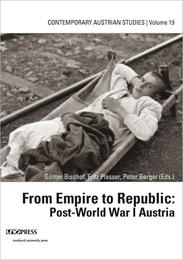Detailansicht
From Empire to Republic: Post-World War I Austria
ISBN/EAN: 9783902719768
Umbreit-Nr.: 1023892
Sprache:
Englisch
Umfang: 448 S.
Format in cm: 2.9 x 22 x 15.5
Einband:
kartoniertes Buch
Erschienen am 08.10.2010
Auflage: 1/2010
- Zusatztext
- The breakup of the Habsburg Dual Monarchy and the redrawing of the political map of East Central Europe constituted a major experiment in "destroying the old, and creating the new" (O. Hwaletz). Historians are more inclined to study the rise of empires than their demise and aftermath. The eighteen essays in this volume offer fresh perspective and innovative scholarship on the difficult transition from empire to republic for the small state of Austria, newly created by the Allied peacemakers in Paris in 1919. These essays also deal with complex challenges of nation building after a major war as well as the ambiguity inherent in the creation of new institutions in politics, economics, social life and culture. In 1919 the government of the instable and fledgling Republic of Austria faced the task of integrating more than a million of returning war veterans and taking care of 110,000 wounded veterans returning from the frontlines. The government was also confronting revolutionary turmoil in the streets of Vienna, a neartotal collapse of the agricultural and industrial economies and near-mental breakdown from the trauma of defeat. Hyperinflation produced a financial crisis in the early 1920s and major economic challenges in the banking and industrial sectors. The redrawn borders produced loss of German ethnics and major demographic shifts. Pan-Germanism was an ideology popular in all political camps. "Austrians" - no longer dominant in a vast empire - were searching for a new identity. After four years of war, Austrians had to confront defeat and constructed a national memory from painful personal remembrances. Most families were dealing with family members returning from a long and destructive war with limbs missing and souls deranged. In spite of ideological conflict between the major political camps, a national cultural revival ensued and new educational institutions were born. Cover photo: A severely wounded soldier from the battle on the Isonzo front awaits transport to the hospital on 23 August 1917. (Photo courtesy of Picture Archives of the Austrian National Library)
- Kurztext
- Der von Günter Bischof, Fritz Plasser und Peter Berger herausgegebene Band 19 der Reihe "Contemporary Austrian Studies" trägt den Titel "From Empire to Republic: Post-World War I Austria". Das Ende der Habsburgischen Doppelmonarchie markiert einen Wendepunkt in der österreichischen Geschichte. Die 18 hier versammelten Aufsätze beschäftigen sich entgegen dem derzeitigen Trend weniger mit dem Aufstieg der Habsburgerdynastie als vielmehr mit der Frage des Zusammenbruchs dieser Epoche und zeigen die Herausforderungen, mit denen die junge Republik Österreich 1919 konfrontiert wurde. The breakup of the Habsburg Dual Monarchy and the redrawing of the political map of East Central Europe constituted a major experiment in "destroying the old, and creating the new" (O. Hwaletz). Historians are more inclined to study the rise of empires than their demise and aftermath. The eighteen essays in this volume offer fresh perspective and innovative scholarship on the difficult transition from empire to republic for the small state of Austria, newly created by the Allied peacemakers in Paris in 1919. These essays also deal with complex challenges of nation building after a major war as well as the ambiguity inherent in the creation of new institutions in politics, economics, social life and culture. In 1919 the government of the instable and fledgling Republic of Austria faced the task of integrating more than a million of returning war veterans and taking care of 110,000 wounded veterans returning from the frontlines. The government was also confronting revolutionary turmoil in the streets of Vienna, a neartotal collapse of the agricultural and industrial economies and near-mental breakdown from the trauma of defeat. Hyperinflation produced a financial crisis in the early 1920s and major economic challenges in the banking and industrial sectors. The redrawn borders produced loss of German ethnics and major demographic shifts. Pan-Germanism was an ideology popular in all political camps. "Austrians" - no longer dominant in a vast empire - were searching for a new identity. After four years of war, Austrians had to confront defeat and constructed a national memory from painful personal remembrances. Most families were dealing with family members returning from a long and destructive war with limbs missing and souls deranged. In spite of ideological conflict between the major political camps, a national cultural revival ensued and new educational institutions were born.
